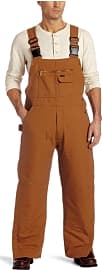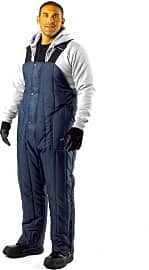The 10 Best Men's Insulated Bibs

This wiki has been updated 41 times since it was first published in December of 2016. Whether you're headed outdoors for a long day of work in winter, gearing up for a day of backcountry snowmobiling, or planning to enjoy a day on the slopes, it's important to put on the right cold-weather gear. One of these pairs of properly insulated bibs will help keep your legs and torso warm and dry, and can protect you and your clothing from all sorts of dirt and debris. When users buy our independently chosen editorial recommendations, we may earn commissions to help fund the Wiki.
Editor's Notes
February 03, 2021:
We removed the Walls Country and White Sierra Toboggan, due to availability issues, but quickly found two excellent replacements for these options.
Our first new addition, the Mountain Hardware FireFall, are available in five colors – including one camoflage textile – and, in my opinion, look surprisingly fashionable for a garment in this category. They’re equipped with several zippered pockets, including a mesh compartment designed for avalanche beacons, and backed by a limited lifetime guarantee.
Our second selection, the Striker Ice Hardwater, features proprietary technology that can keep the wearer buoyant for up to two hours. While we certainly hope that none of our users will ever need to take advantage of this ability, it would certainly be well appreciated if the floor of your ice fishing shack ever gives out. They also have several thoughtful inclusions built into them, like removable hand-wipe towels and a forcep holder.
It should be noted that, while we were quite impressed by the Hardwater’s design, we still decided to include it further down our list, as this pair is quite expensive, and at the time of this writing were supported by few user reviews — positive or otherwise. The test of time is what really sorts out quality gear of this sort from the mediocre stuff, so we’ll use incoming audience feedback – between now and the next time we revisit this list – to determine whether this pair deserves to be ranked a little higher next time.
October 15, 2019:
This year, we eliminated the Arctix Avalanche from our rankings after noticing an unusual level of blown-out-crotch complaints. As is my experience, the first thing to go on a solid set of bibs should usually be the knees (barring a frayed hem in the event of a too-long inseam). Naturally, this will depend on the type of work you’re doing, but an over-engineered crotch that can pass the test of time is typically a sign of a manufacturer that understands the needs of this market and takes their product seriously. In this respect, Arctix seemed to be lacking.
We took advantage of the absence created by the Avalanche’s dismissal, and filled that void with the Tough Duck 7537, even going so far as to allow our new addition to bump Carhartt from the number-one spot for these rankings. Tough Duck’s a Canadian company with a strong reputation for turning out gear that lives up to their titular toughness. Having owned several pairs of Carhartt and Tough Duck bibs, I can attest that both companies produce excellent apparel, but in my experience the durability offered by Tough Duck’s textiles just can’t be matched. That being said, it’s also my experience that Carhartt’s hardware is more rugged than Tough Duck’s. So, depending on the nature of the work you’re doing, Carhartt might still be the smarter pick.
Stay warm out there!
Garments Of Function And Simplicity
The bib is usually clasped at the chest and features two shoulder straps that are designed to keep it properly held up and secured on the body.
Imagine that you're a construction worker responsible for erecting homes and other large buildings. When thinking about the gear necessary to complete certain tasks, your first instinct might be to consider one of many power tools like a cordless drill or a hard hat to protect your head from falling objects while on the job. But you might not think quite as much about the articles of clothing you plan to wear. Now imagine being forced to complete these tasks while working in the bitter cold. While you'll certainly need power tools to maximize efficiency and a hard hat for jobsite safety, you'll also need something to keep your body warm and dry when working in those rough outdoor conditions. In such situations, consider adding an insulated bib to your gear arsenal.
What exactly is an insulated bib, anyway? To set the record straight, we're not talking about baby bibs that contain mealtime messes. Similar in style to overalls, but different from the coverall that is worn as a full body suit for the legs, back, arms, and chest, the adult-sized insulated bib is a sleeveless garment that fits over regular clothing and extends from the legs down to the ankles, like a pair of trousers. The bib is usually clasped at the chest and features two shoulder straps that are designed to keep it properly held up and secured on the body. The exteriors of insulated bibs are made from a variety of materials, including thick woven canvas, denim, and cotton twill, while their interior linings are fashioned from arctic-grade quilted nylon and feature extra polyester padding, making them conducive to working in particularly frigid conditions.
It's important to realize that insulated bibs don't limit your activities to only industrial-type applications or outdoor farming projects. For example, these bibs can be used to keep athletes warm when skiing or snowboarding. In addition to helping retain body heat in the snow, insulated bibs are also designed to provide superior flexibility and freedom of movement, regardless of the activities for which they're worn. Many are also fashioned with water-resistant materials for ensuring protection from the rain or when you're on the hunt for game in unfamiliar wilderness. If you find yourself in dangerous and/or dark environments, insulated bibs can shed additional light on your predicament when they're equipped with reflective striping, delivering extra visibility and safety when you're forced to work and travel at night. Depending on their materials, these bibs are often durable enough for use in the automotive and oil industries, as they can protect ordinary clothes from getting dirty, while simultaneously helping to prevent possible injury from arc flash or other fire hazards.
Wearing What Works
The type of insulated bib you choose to wear will ultimately depend on the intended activity. That said, overall durability and materials should be among your most important considerations. For example, if you're a construction worker or firefighter looking for some extra protection during the winter months, consider a bib made from heavy-duty canvas. Canvas can help to protect both your clothes and body from jobsite hazards and messes without sacrificing additional warmth. If you plan to use your bib for recreational purposes (i.e. skiing or other high-action sports), definitely consider a solution with durable stitching, reinforced bar tacks, and sturdy zippers, all of which allow the garment to withstand heavy abuse over time.
For example, if you're a construction worker or firefighter looking for some extra protection during the winter months, consider a bib made from heavy-duty canvas.
Having an insulated bib with extra utility and/or pass-through pockets will also come in handy when you need quick access to tools like hammers and wrenches.
Next, remember that the bib you choose will be worn over your regular clothes, so be sure to add at least four to six inches to your chosen waste size in order to ensure superior mobility and comfort on the job.
Visibility is another thing to keep in mind. Regardless of whether you're farming, hunting, fishing, or simply looking for wintertime fun in the snow, an insulated bib equipped with reflective materials will keep you safe when performing physical activities at night.
A Brief History Of Insulated Bibs
The insulated bib represents an example of a garment designed to meet the needs of the wearer, as opposed to prioritizing style and fashion over function. The earliest reference to these types of bibs dates back to 1776, when they were used by slaves as protective garments for dealing with particularly harsh outdoor working conditions.
Harry David Lee designed the first bib overalls in 1911, consisting of pants with pockets sewn to a shirt with a bib and straps for the shoulders.
The first evidence for the mass production of bib-like overalls occurred in the 1890s, thanks to both San Francisco businessman Levi Strauss and Reno, Nevada, tailor Jacob Davis, both of whom were granted a patent to create work pants reinforced with metal rivets, leading to the birth of the first blue jeans. These early jeans resembled overalls and featured suspenders attached to denim pants with buttons.
Harry David Lee designed the first bib overalls in 1911, consisting of pants with pockets sewn to a shirt with a bib and straps for the shoulders. Lee's garment became known as the Lee Union-All by 1913, which became popular clothing for workers, women, and children. Popularity for Lee's invention was carried into World War One due to its durability and ease of use in the United States Military.
The Great Depression of the 1930s later saw overalls worn by the poorest members of American society, including farmers, miners, loggers, and railroad workers.
During the feminist protests of the 1970s, women began wearing overalls as part of a continuing fight for gender equality.
The insulated bib of the 21st century has been adapted from prior overall designs. It delivers an existing focus on practicality, protection, and versatility that lends its design to use in many professional and recreational settings, depending on a person's needs.















